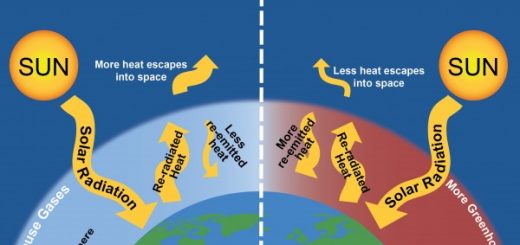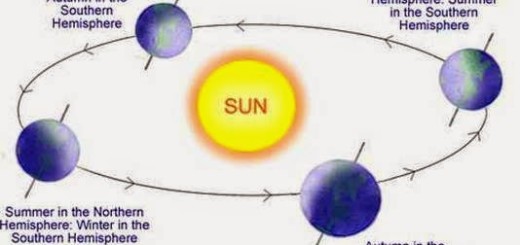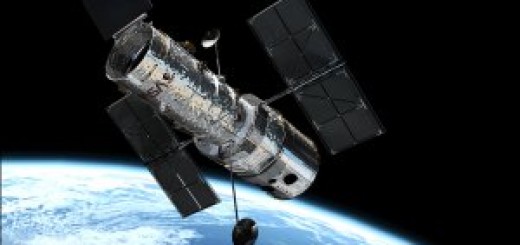Earth’s crust, Types of rocks, Igneous rocks, Sedimentary rocks and Metamorphic rocks
Granite has a coarse texture, while basalt has a smooth texture because the size of crystals of minerals forming granite is large, while the size of crystals of minerals forming basalt is small. The components of granite rock can be seen by the naked eye because it is a plutonic rock that has large crystals. Limestone consists of mineral calcite due to the precipitation of calcium carbonate in lime solutions.
Components of the Earth’s crust
The Earth consists of three layers, The outer layer is called the Earth’s crust. Scientists classified the Earth’s crust into two main parts which are the soil and solid basis. The soil is a thin non-compacted layer, which covers the Earth’s crust. It is a superficial (upper) layer of the Earth’s crust. It is a thin, fragmented and loosened layer. It consists of a mixture of mineralogical substances, water, air, decayed organic materials & plant roots.
Rock is a natural solid material, that exists in the Earth’s crust and it is formed of one mineral or a group of minerals. It is a lower layer of the Earth’s crust beneath the soil. and it consists of different types of rocks.
The plant roots extend easily through the upper part of the Earth’s crust but can’t extend through its lower part because the upper part is a fragmented and loosened layer but the lower part is a solid material, that consists of different types of rocks.
Classification of rocks
Rocks are classified according to their way of formation into three groups, which are Igneous rocks, Sedimentary rocks, and Metamorphic rocks.
The igneous rocks
The outer core of the Earth contains molten metals, which are known as magma. Magma is a very hot thick (viscous) liquid underneath the Earth’s crust. When a volcano occurs, the magma at the bottom of the Earth’s crust is pushing upwards. A part that fills some gaps and cracks of the Earth’s crust and the other part is extruded from the crater of the volcano to the surface of Earth in the form of volcanic flows, which is known as lava.
Lava is the magma when it reaches the Earth’s surface or it is the volcanic flows that spread on the volcanic sides. When magma and lava cool and solidify, they form the igneous rocks. Igneous rocks are rocks formed by solidification of the magma underneath the Earth’s crust or lava on the Earth’s surface.
Types of igneous rocks
Igneous rocks can be divided according to the site (place) of their formation in proportion to the Earth’s surface into two main divisions, which are: plutonic rocks and surface or volcanic rocks.
Plutonic rocks
The magma at the depths of the Earth’s crust gets cool slowly, therefore the minerals that form these rocks take a long time to crystallize, so their crystals are large-sized. Plutonic rocks have coarse texture because the size of crystals of minerals forming them is large. They are formed in the depth of the Earth’s crust, where the minerals accumulate forming huge masses of rocks covering wide areas.
Surface or volcanic rocks
The lava cools quickly on the surface of the Earth’s crust, therefore the minerals that form these rocks take a short time to crystalline, so their crystals are small-sized. Surface or volcanic rocks have smooth texture because the size of crystals of minerals forming them is small.
Volcanic rocks are formed over the Earth’s surface, where the minerals accumulate forming a flow of lava around the sides of the volcano. Volcanic rocks contain small circular holes due to the extruding of gases from volcanic flows during their cooling and formation of rock.
Examples of igneous rocks
Granite is a plutonic igneous rock, It is pink or grey. The crystals of minerals forming it are big (can be seen by the naked eye). Granite is heavy. It has a rough texture. It is solid, cohesive and it isn’t easily broken. It is found in the Eastern Desert and the Sinai Peninsula. It consists of 3 main minerals, which are Quartz, Feldspar, Mica (Dark mica and Light mica).
Basalt is a volcanic igneous rock, It is dark-colored, The crystals of minerals forming it are small (can’t be seen by the naked eye). Basalt has small circular holes. It has a smooth texture. It is extremely hard. It is found in Egypt in Abou-Zaabal, El-Fayoum and Near Abou Rawash. It consists of 3 main minerals, which are Olivine, Feldspar, and Pyroxene.
The sedimentary rocks
They represent about 5% only of the total volume of the Earth’s crust rocks. They form a thin cover, that wraps about 75% of the surface of the Earth’s solid mass.
Formation of sedimentary rocks
Sedimentation rocks are rocks formed from the cohesion of sediments. They are rocks formed from fragmentation and sedimentation of old rocks. The formation of sedimentary rocks takes place in three successive stages, which are Erosion, Transportation, and Sedimentation:
- Erosion (fragmentation and disintegration) of the igneous, sedimentary or metamorphic rocks that are previously existed.
- Transportation of the detritus (fragmented particles of rocks) by water currents or by air, where these particles are deposited.
- Sedimentation (deposition) of rocks particles in an aqueous or an aerial medium, later these deposited particles adhere together forming the sedimentary rocks.
On increasing the pressure on the grains of rocks, the cohesion of the grains of rocks increases by passing time forming layers above each other, the layers in the bottom are older and the above ones are more recent.
The cohesion of layers of sedimentary rocks increases by passing time because the sediments of the bottom layers are exposed to high pressure resulted from the weights of the deposits above them, this causes a decrease in the ratio of water existing between the grains.
Examples of sedimentary rocks
- Sandstone consists of sand grains that are less than 2 mm in diameter. The main component almost is quartz mineral, its colour is yellow, It has a coarse texture, it is cohesive, and it has thin layers.
- Limestone consists of the precipitation of calcium carbonate (CaCO3). It consists of minerals calcite (calcium carbonate), its colour is white, it has a smooth texture, it is less cohesive and it has thin layers.
How can you differentiate between sandstone and limestone?
By adding dilute hydrochloric acid to each of them, Sandstone (No reaction takes place to Sandstone), Limestone (A chemical reaction takes place with an effervescence due to evolving of carbon dioxide gas).
When calcium carbonate precipitates in lime solutions, Limestone is formed. Effervescence takes place when hydrochloric acid is added to a sample of limestone due to evolving of carbon dioxide gas.
We can differentiate between sandstone and limestone from colour and texture because sandstone is yellow in colour and its texture is coarse, while limestone is white in colour and its texture is smooth.
The metamorphic rocks
When old rocks (igneous or sedimentary) are subjected to pressure and high temperature, they convert into metamorphic rocks. This conversion often depends on the type of rock that surrounds the magma, the mass of the magma and its temperature. Metamorphic rocks are rocks that originated as a result of exposing old rocks (igneous or sedimentary) to the factors of pressure and high temperature.
Examples of metamorphic rocks
Marble is produced from the conversion of limestone. It has more solidity and it is cohesive than limestone. Its texture is coarse (rough). Its colour is white if it is pure and has other colours when it contains impurities.
The Earth, Importance of Earth’s atmosphere, hydrosphere, gravity, pressure & temperature
Stars, Galaxies, Solar system, Planets, Moons, Asteroids, Meteors, Meteorites & Comets
The volcanoes and the safety precautions must be taken at the occurrence of the volcanoes



